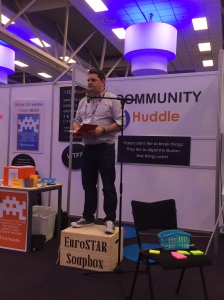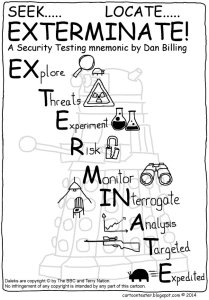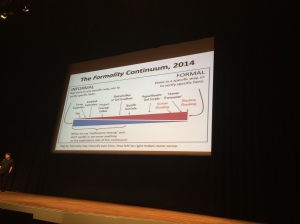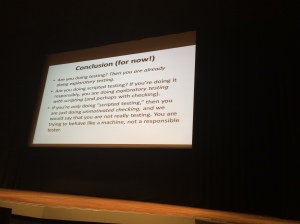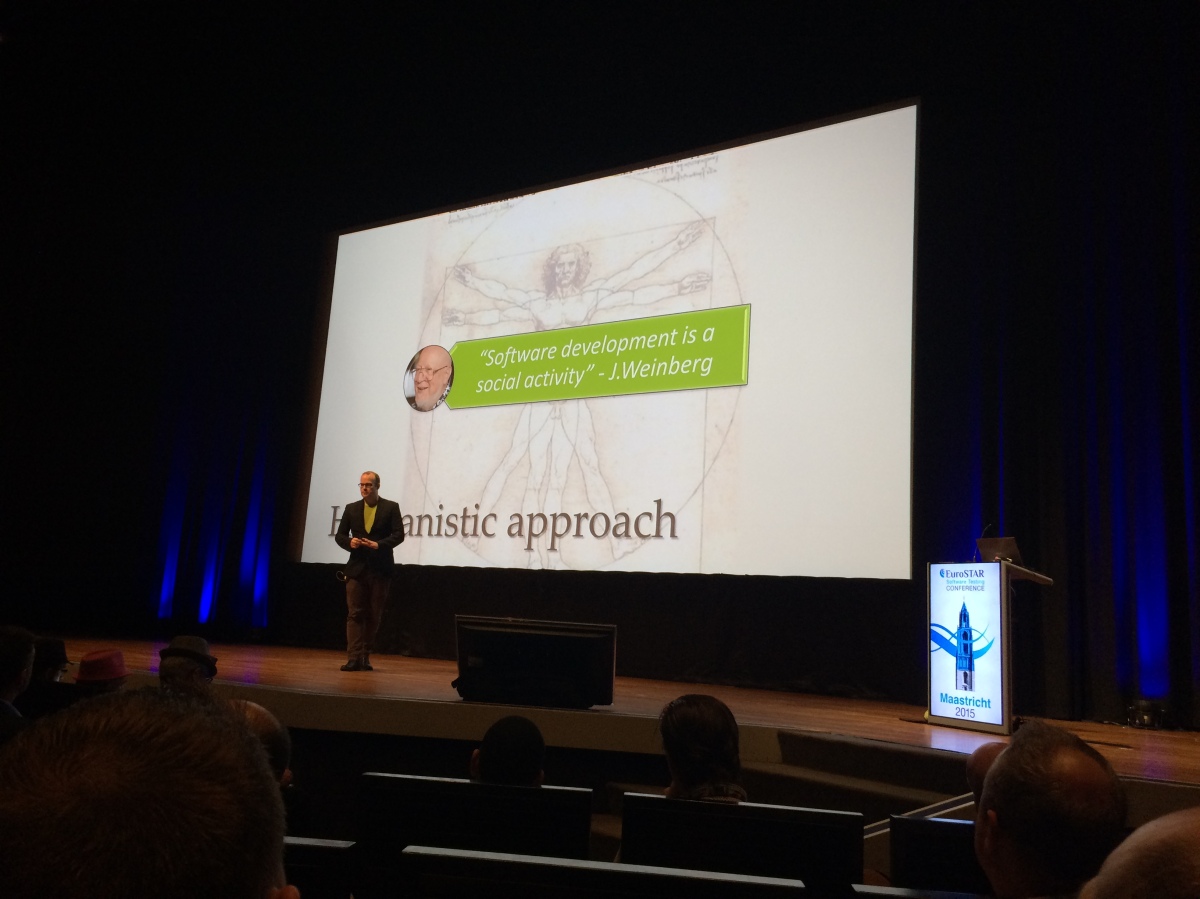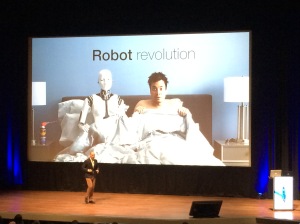Day 2 of EuroSTAR 2015 kicked off, of course with the Ruudmap of the day, by conference chair Ruud Teunissen. The day was packed with one keynote, 24 track sessions, and “Lightning Strikes the Speakers”.
The keynote of the day was delivered by Jeffery Payne about “Test Automation. The DevOps Achilles Heel.” And in reference to yesterday’s keynote that was all about the future, DevOps is already here! DevOps is a philosophy to get everybody on the same page and to foster collaboration and communication. The statement “we can’t apply DevOps here” is just an excuse for Jeffery, because he saw the DevOps approach work in many different environments.
The essential conflict of Dev vs. Ops is, that devs have the desire for rapid rollout, while the ops people have the desire for stable conditions. As in yesterday’s talk from Sujay, Jeffery described Continuous Integration and Continuous Delivery as his key elements for a successful DevOps approach. Whereas the other CD thing – continuous deployment – might work well for some big companies and also lots of small ones, that component does not suit many.


Automation of everything along the chain makes it possible to “fail fast” and saves time on time-consuming activities, that can be better achieved by a machine or script.
“DevOps is the best thing that ever happened to testing.” I am not so sure about that. In the overall process of software development the DevOps approach forces collaboration, which is good for testing. Because most issues in a project are interpersonal and are not due to technical issues.
I found the “Test results are “blinky”” slide funny and sadly true in too many cases. But the ability of DevOps tools to create fancy and blinky test reports does not improve the situation that management doesn’t understand what testing is. The communication between testers and management needs to be improved and not be misrouted via blinky reports, just because you can.
One of the closing statements was that you can start running more automated tests. But do I really want to that? Why can I not use the tests that matter most and abandon the rest, because they will be difficult and expensive to maintain. After the test run, you need someone to interpret the results. Good testing is not that you simply count on passed tests and pass the quality gate to the next environment.
Overall I had mixed feelings about the keynote. It was a solid overview of the elements of DevOps, but especially towards the end I found that Jeffery was sending the wrong signals what DevOps is doing to testing. It might still be the best thing that ever happened to testing, but if so, then for some other reasons. At least from my point of view.
Next on schedule was the track session from Paul Coyne about “Everything I know about testing I learned from the scientific method”. I wrote about this experience in an extra blog post.
I had the honor that Michael Bolton took some, well not only some, but about 2 hours, of his precious time to review one of my upcoming blog posts. And the discussions we had in the test lab during the review, also with other people, like James Lyndsay, were intense and fantastic. I missed two track sessions due to that fact, but I hope everyone understands that it was for a very good reason.
I will end writing for tonight and continue tomorrow. Stay tuned for info about the ISO 29119 discussion track, Kevin Harris’ “Top 10 Mistakes Testing in Agile”, Grace O’Mahony’s “just one slide inspired me to be a better coach for testers in Agile” and the really intense but insightful “Lightning strikes the Speakers” session. And of course some photos from the Conference Awards Dinner.
[continue]
During the lunch break I met Alan Page and had the chance to thank him for his inspiring podcast and the ideas he and Brent are sharing. If you haven’t listened to them before, do so now. They deserve a fourth listener. It’s great content.
After the lunch break I was going to the “Let’s talk about the ISO29119 Standards” talk/discussion. To be honest and frank it was a bit disappointing. The introduction was, due to the short amount of time, too shallow for the audience that had not heard about the standard before. When the questioning round was open the expected suspects raised their hands. The first question came from a person, whose name I sadly did not get, who was the first person I ever met who was actually using ISO29119 and likes it. His question was about a problem, that he struggles with the many “test plans” the standard describes, and if there isn’t a better nomenclature to name the different documents to produce. And there a lot of documents titled “test plan” something in the standard. After that Iain McCowatt asked for new evidence that proofs the standard to be correct, as mandated by ISO for a standard to have to be accepted. But it seems that part is still missing, and still the standard got accepted so far by the board. Michael Bolton questioned the standards that were used to produce the standard, and Karen Johnson asked a most fascinating question – at least for me – why are Anne Mette and Stuart are engaged personally professionally in creating such a standard. When speaking with Karen afterwards, which was an inspiring experience in just 5 minutes, she summarized the answers very well. They saw the different directions testing was heading (both have many years of experience) and feared the unstructured chaos the world of testing became over the years, and they wanted to bring structure back to chaos.
The session was a bit disappointing for me, the discussion part was rather unstructured, and I missed information actually showing that the standard can be helpful, besides creating huge amounts of documents. And I stay with my statement, for what they intended to do, why not create a body of knowledge, like the PMBoK. You can have all elements and simply pick those you need or want, without having a huge bureaucracy of justifying why not to use several parts of a standard. Stuart answered that question for me months ago with, “because the ISO doesn’t produce BoK”. My question today would be, did ISO ask Stuart to write a standard or was Stuart asking ISO to create one? Is there really a need for that standard in form of a standard?
And to conclude for now: As long as bugs don’t obey to standards, why should I?
Next up was one of the many NewVoiceMedia speakers, Kevin Harris. Sadly I missed Rob’s and Raji’s talks earlier that day. The room was packed, people were even sitting on the floor.
I thought about writing an extra blog post about Kevin’s experience report and his lessons learned, but that might give away a bit too much for people who want to see that talk in the future. For me it was an interesting talk from two different perspectives. The presentation itself was well crafted, with the right amount of slides, the right speed and a balanced amount of information for a 45 minute talk. I don’t know who influenced whom, but it reminded me a bit of Rob Lambert’s talk from NTD earlier this year. Since they are colleagues, the idea might not be that wrong. The show was really good!
Now to the content. The topic was about Kevin’s “Top 10 Mistakes Testing in Agile”. In my current projects we are far from Agile and the first ~10 years of my career was pure waterfall. So I have no personal experience with Agile in any form. All I know about Agile is from talks, articles and discussions. So I was looking forward to see what could go wrong with Agile. To give a short summary, the important takeaways described some of the basic principles of Agile and SCRUM projects, as far as I know theoretically. But it was interesting to hear the examples Kevin gave, why it went wrong in the first place, when they should’ve known better.
Value the kick-off and ask all the questions, especially as a tester. Put EVERYTHING on the Kanban board that needs to be done in the project. Make stories as small as possible to decrease the complexity. Outsourcing testing, especially into a different time zone, increases cycle time and silo thinking, which brings us back to waterfall. So keep your team together. Which was also the next message. Try to keep the team stable. Let developers automate the checks. Communication is key and can save you valuable time. Don’t do more than necessary. Share responsibilities and tasks, don’t create key players. For Agilists that should be nothing too surprising, right? Well for waterfall, V-model, and whatever-not-SCRUM people, this is often like the complete opposite of their reality.
Well that was only nine. The 10th takeaway was that testers should not brag about the bugs they found. For me that would mean a rough change in motivation for many testers. Yes, we should shift left and find the bugs as early as possible, but why should we not be proud that we caught some? I think I will ask Kevin to find more about it.
And then it was time to hear Iain McCowatt stand up on the Soap Box and give his version on the topic of ISO 29119. I hope it will be soon available on the TestHuddle. I will update my blog as soon as I know it’s up.
Next on my agenda was Grace O’Mahony and the topic of “Just one slide inspired me to be a better coach for testers in agile teams”. To be honest I did not expect much more than one slide, but it was a whole more. Grace told us her experience about introducing 20 teams to Agile and their different problems and how she was able to overcome them. “The slide” was from Fran O’Hara from his talk about “Acceptance Testing in Agile – what does it mean to you?” Sadly the slide was not at the center of the presentation, and Grace went pretty quick over it. She described auditing her teams and realizing that the testers were not as proactive as they should be in an Agile context. The result was even that most of the teams categorized themselves as A or B. They had to accept that change is slow, but they got through the transformation, released the stress from the testers and had more happy people. All in all, Grace presented her success story on how the model from Fran O’Hara helped her to improve her teams. I would have liked to hear more about THE slide, what was the key element that made her realize how to benefit from that and how it changed her approach. The presentation had lots of slides and Grace was rushing a bit through them. For me the title was a bit misleading. But that’s just my view.

After a short visit to the TestHuddle and the Testlab people filled the auditorium for “Lightning strikes the Speakers!”
The show started with a special ensemble. I’ve made a video, but still need to edit it. It will be published here soon.
“Lightning strikes the Speakers” are seven speakers with 5 minutes each. If the 5 minutes are out and the speaker is still speaking, he is struck by lightning, and yikes, that was loud. The topic was “Testing in the year 2030”.
Iris Pinkster – from team *T*E*S*T – Clinic – started with the “Human Factor”. Humans are good at throwing things over the fence, but in Agile / DevOps approaches you have to work together. So think up a new process and realize that you are a team!
Jeffery Payne referenced to the opening keynote and the future of testing the Internet of Things. It will be the age of non-functional testing. 1. Fault Tolerance, 2. Robustness in Error-handling, 3. Privacy
Derk-Jan de Grood‘s message was, that we have to improve our testing. In Agile the responsibility is placed low. And before he was struck by lightning he asked the important question, is testing at the level we want it to be?
Michael Bolton was criticizing that we are sloppy on thinking and that testers and managers don’t communicate well. Exchange “verify that” with “challenge the idea that”, and “validate” with “investigate” or “look for problems”. Many testers are demoralized by management and processes, and are not curious and playful anymore. Change your language and improve your communication.
Rikard Edgren’s topic was that tester’s bring new perspectives and ideas. He described his first assignment, where the developers were all trained on the same academy. Rikard studied philospohy and other non-IT-related topics. Rikard was the first one to bring new perspectives to the project. Rikard challenged all testers “what are the new perspectives we will find?”
Rob Lambert‘s view into the future was that by 2030 there should be more qualified people to hire. He has the problem that it’s hard to find good people today. And he presented us his “10 things to improve”.

Last, but not least, Kristoffer Nordström predicted that in 15 years most testers don’t work in testing anymore. Because we get what we pay for, and a low price brings you low skills. But testers in Agile need lots of skills. Cheap outsourcing is the norm and there are many bad/non-thinking testers out there. Kristoffer’s dream is to hire sapient testers and companies should invest in their people, also to reduce turnover. Companies need to change from quick wins to long term investment in their people, who take pride in building skills.
The keynote with its seven messages was very intense and had great messages.
At 6.45pm the buses left for “La Caverne” in Valkenburg for the EuroSTAR Conference Awards Dinner. A nice restaurant located in a cave, yes again in a cave. The caves were full, dinner was delicious, and there was plenty of wine. I had the honor to share my table with Carly Dyson, Kristoffer Nordström, community-report Nick Shaw, Paul Coyne, and Iain McCowatt. Folks, I enjoyed the passionate discussions, it was fantastic!
And the winners are:
Best Tutorial: Rob Lambert
Best paper: James Thomas
Tester of the Year: James Lyndsay
Well deserved!
The evening was fun, but after ~19 hours I was glad the day was finally over.











